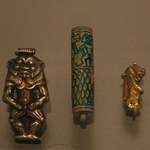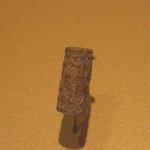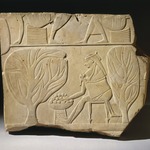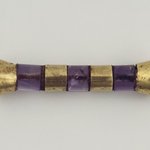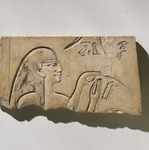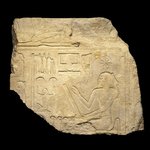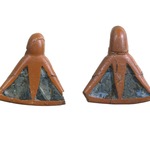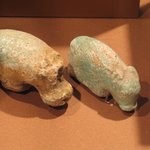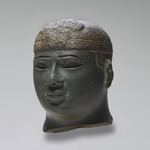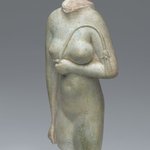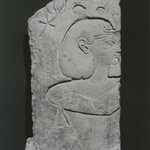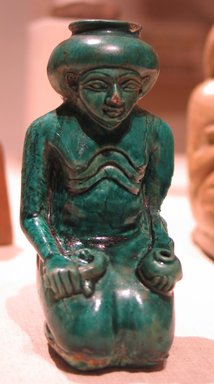
Vessel in the Form of a Kneeling Woman
Egyptian, Classical, Ancient Near Eastern Art
On View: 19th Dynasty to Roman Period, Martha A. and Robert S. Rubin Gallery, 3rd Floor
MEDIUM
Steatite, glaze
DATES
ca. 1336–1327 B.C.E., ca. 1327–1323 b.c, or ca. 1323–1295 B.C.E.
DYNASTY
late Dynasty 18
PERIOD
New Kingdom
DIMENSIONS
3 13/16 x 2 in. (9.7 x 5.1 cm) (show scale)



COLLECTIONS
Egyptian, Classical, Ancient Near Eastern Art
ACCESSION NUMBER
49.53
CREDIT LINE
Charles Edwin Wilbour Fund
PROVENANCE
Archaeological provenance not yet documented; by 1869, acquired by William Henry Forman of Dorking, England; 1869, inherited by Mrs. Major Burt of Dorking; circa 1889, inherited by Alexander Henry Browne of Callaly Castle, Northumberland, England, no. 1535; June 20, 1899, sold at Sotheby's London, "The Forman Collection of Antiquities, and Objects of Art of the Renaissance, etc.," lot 223; between 1899 and 1926, provenance not yet documented; by January 16, 1926, acquired by Thomas David Gibson-Carmichael of Skirling, Scotland; June 9, 1926, purchased from the estate of Thomas David Gibson-Carmichael at Sotheby's London, "The Collections Formed by the Late Lord Carmichael of Skirling," lot 273, by Kalebdjian Frères of Paris, France; between 1926 and 1933, provenance not yet documented; by July 1933, acquired by Maurice Nahman of Cairo, Egypt; July 24, 1933, purchased from Maurice Nahman by the Brummer Gallery, New York, NY, P10019; March 3, 1949, purchased from the Brummer Gallery by the Brooklyn Museum.
Provenance FAQ
CATALOGUE DESCRIPTION
Green glazed stone figure of kneeling woman. Figure kneels with body resting on legs. Hands extended on thighs; left hand claps nw pot; in right hand a curved horn. Across torso three conventionalized lines of fat. Headdress of Middle Kingdom type with long braid at back. Circular opening on top of head. Body hollowed; oblong opening at base. Use unknown. Apparently was originally fitted to a base.
On the left side of the figure there is a line which starts on the palm of the hand and runs down over the thigh onto the calf of the leg. That portion of this line which lies on the leg is cut by a series of short parallel lines. These lines, which are beneath the glaze, appear to be painted on. The apparent continuation of this line, from mid-calf down under the leg, is a crack which is also beneath the glaze. There is no other trace of paint on this piece.
Condition: Rim chipped. Area missing on left side adjoining left elbow.
EXHIBITIONS
MUSEUM LOCATION
This item is on view on the 19th Dynasty to Roman Period, Martha A. and Robert S. Rubin Gallery, 3rd Floor
CAPTION
Vessel in the Form of a Kneeling Woman, ca. 1336–1327 B.C.E., ca. 1327–1323 b.c, or ca. 1323–1295 B.C.E. Steatite, glaze, 3 13/16 x 2 in. (9.7 x 5.1 cm). Brooklyn Museum, Charles Edwin Wilbour Fund, 49.53. Creative Commons-BY (Photo: Brooklyn Museum, CUR.49.53_wwg8.jpg)
IMAGE
installation, West Wing gallery 8 installation, CUR.49.53_wwg8.jpg. Brooklyn Museum photograph, 2006
"CUR" at the beginning of an image file name means that the image was created by a curatorial staff member. These study images may be digital point-and-shoot photographs, when we don\'t yet have high-quality studio photography, or they may be scans of older negatives, slides, or photographic prints, providing historical documentation of the object.
RIGHTS STATEMENT
Creative Commons-BY
You may download and use Brooklyn Museum images of this three-dimensional work in accordance with a Creative Commons license. Fair use, as understood under the United States Copyright Act, may also apply.
Please include caption information from this page and credit the Brooklyn Museum. If you need a high resolution file, please fill out our online application form (charges apply).
For further information about copyright, we recommend resources at the United States Library of Congress, Cornell University, Copyright and Cultural Institutions: Guidelines for U.S. Libraries, Archives, and Museums, and Copyright Watch.
For more information about the Museum's rights project, including how rights types are assigned, please see our blog posts on copyright.
If you have any information regarding this work and rights to it, please contact copyright@brooklynmuseum.org.
RECORD COMPLETENESS
Not every record you will find here is complete. More information is available for some works than for others, and some entries have been updated more recently. Records are frequently reviewed and revised, and we welcome any additional information you might have.


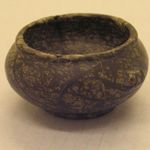
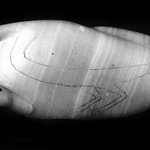

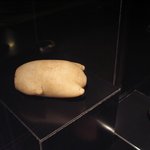
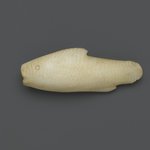
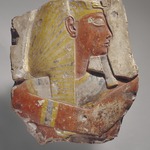
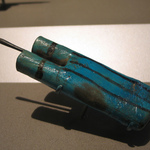
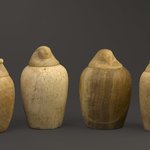
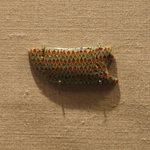


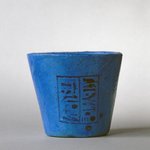
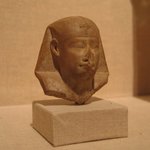
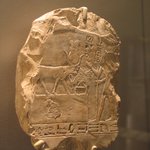


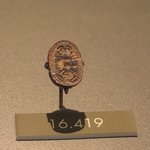
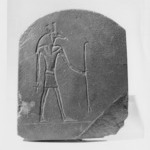

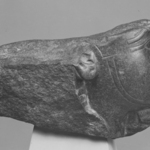
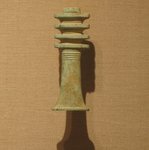
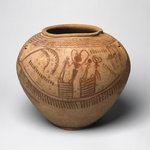

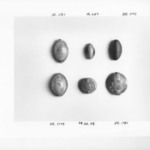
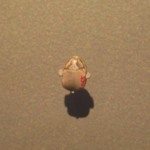
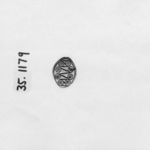
![Stamp Seal of Meru the Answerer of Horus [the King]](https://d1lfxha3ugu3d4.cloudfront.net/images/opencollection/objects/size2_sq/CUR.36.837_erg2.jpg)

